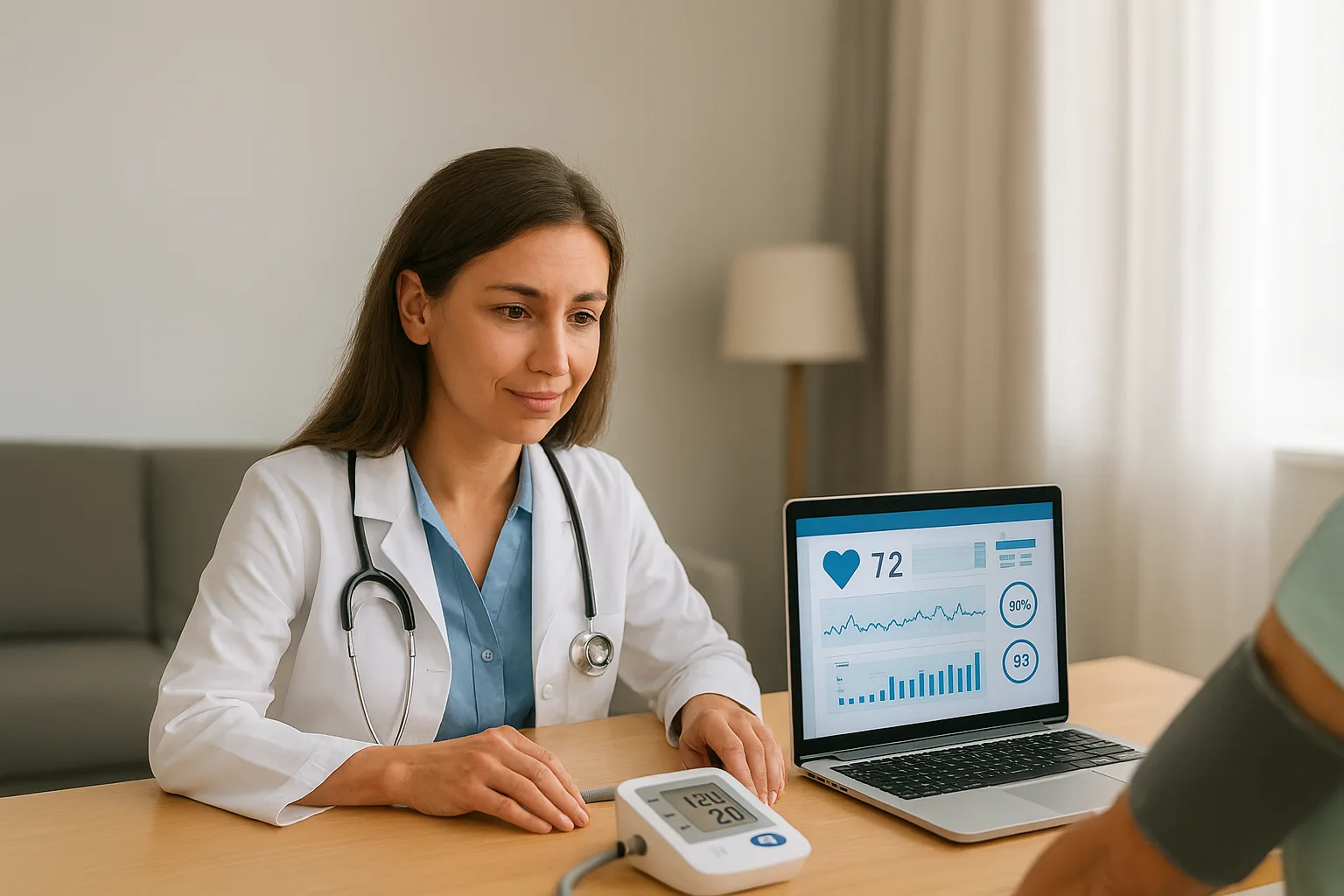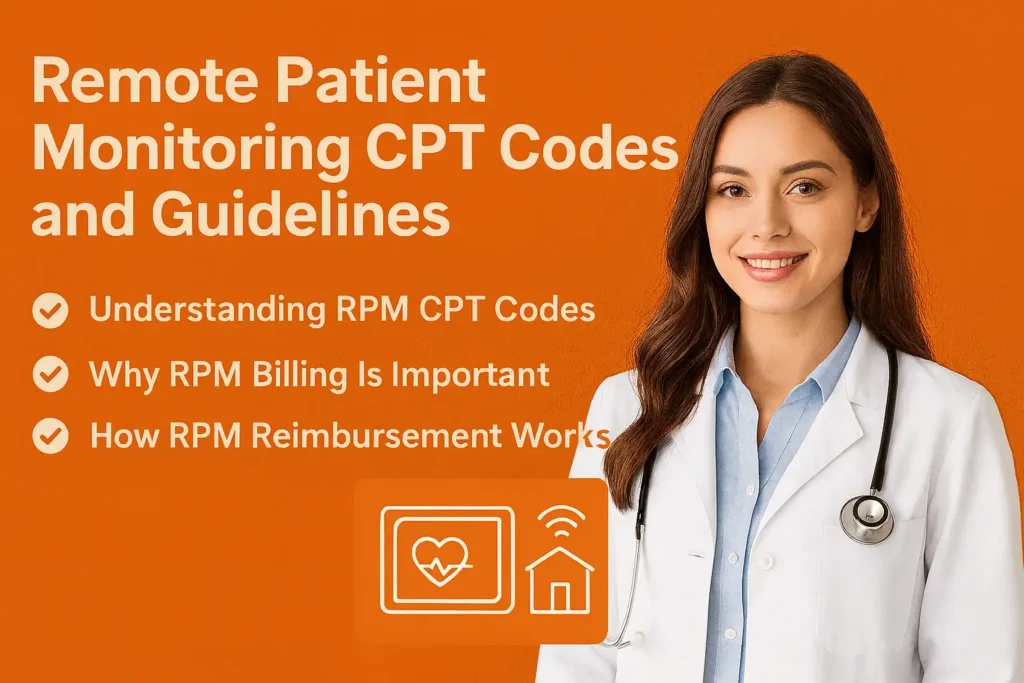Remote Patient Monitoring CPT Codes and Guidelines
- Author : Mark Twain
- Date : 16/11/2025

Remote Patient Monitoring, or RPM, is changing how doctors and healthcare providers take care of patients with chronic conditions. RPM allows care teams to keep track of patients’ health from home and reduce unnecessary clinic visits while providing continuous support.
Understanding Remote Patient Monitoring CPT Codes is important for accurate billing, proper reimbursement, and staying compliant. This guide explains the main RPM CPT codes, how billing works, reimbursement trends, and how Mediclaim Pro Billing can help practices increase revenue and manage RPM services efficiently.

What Are Remote Patient Monitoring CPT Codes
Remote Patient Monitoring CPT Codes are special billing codes used when patients are monitored outside a traditional clinic. These codes tell insurance providers, including Medicare, Medicaid, and private insurers, what services were provided and allow providers to get reimbursed properly.
RPM codes are different from normal telehealth codes because they involve continuous collection of health data, regular review by clinicians, and sometimes live communication with patients. The main codes used for RPM are 99453, 99454, 99457, and 99458. Each code represents a different part of the monitoring process, from device setup to active patient management.
Why RPM Billing Is Important
Proper RPM in medical billing makes sure that healthcare practices get paid for the work they do in remote care. Collecting daily patient data, reviewing trends, and adjusting treatment plans takes real time and effort.
When billed correctly, RPM can increase practice revenue, improve patient engagement, prevent hospitalizations, and support better long-term outcomes.
How Remote Patient Monitoring Reimbursement Works
CMS or the Centers for Medicare and Medicaid Services decides the rules for remote patient monitoring reimbursement. They define which services can be billed, what types of devices are allowed and how documentation should be kept. Private insurers usually follow similar rules.
Payment depends on the type of service, the time spent by clinical staff and how long providers interact with the patient. Mistakes in coding or missing documentation can cause claims to be denied. Working with Mediclaim Pro Billing helps practices stay compliant get claims processed quickly and make sure all eligible revenue is captured.
Key Remote Patient Monitoring CPT Codes
99453 CPT Code
The 99453 CPT code covers the first setup of the RPM device and educating the patient. It includes preparing the device showing the patient how to use it and making sure the patient knows how to send their health data.
This code is billed one time per patient and is essential to start monitoring. Documentation should confirm that the patient was trained and agreed to participate in remote monitoring.
99454 CPT Code
The 99454 CPT code applies to the monthly supply of the RPM device and collecting daily health data for a full 30 days. This includes measurements like blood pressure, oxygen levels, heart rate or glucose readings.
Devices billed under 99454 must be FDA approved and capable of sending data automatically. Using this code correctly ensures recurring monthly revenue which is important for RPM programs.
99457 CPT Code
The 99457 CPT code covers the first 20 minutes each month of interactive monitoring. This involves reviewing patient data providing feedback and adjusting treatment plans if needed.
This code shows the clinical value of RPM because it involves active provider involvement beyond just collecting data. Extra time spent can be billed using 99458 for each additional 20 minutes of patient management.
Core RPM CPT Codes and Requirements
CPT CODE | SERVICE PROVIDED | BILLING FREQUENCY | DOCUMENTATION NEEDED |
99453 | Initial device setup and patient education | One time | Record device setup and patient training |
99454 | Monthly device supply and data collection | Every 30 days | FDA approved device and daily readings |
99457 | 20 minutes interactive monitoring | Monthly | Record live patient communication and review |
99458 | Each extra 20 minutes | As needed | Document additional time spent managing patient |
Advanced Insights for RPM Billing
How RPM Billing Works
RPM billing is more than just submitting a code. It requires tracking devices patient interactions and reviewing the data collected. Billing ensures that providers get paid for the continuous care that happens outside office visits. Unlike standard telehealth RPM provides ongoing oversight which improves patient outcomes.
Also read this: common medical billing mistakes
Steps to Bill Remote Patient Monitoring
- To bill correctly you first enroll the patient and get documented consent.
- Then you provide an FDA approved RPM device and teach the patient how to use it using 99453.
- Next you collect data for a 30 day cycle using 99454.
- Finally you review the data and interact with the patient using 99457 or 99458.
- It is very important to keep accurate timestamps daily logs and notes of all communication.
- Using a platform can help but working with Mediclaim Pro Billing makes sure claims are submitted correctly reduces denials and increases revenue.
New Considerations for 2026
CMS now emphasizes patient engagement telemetry validation and integration with electronic health records. Providers can bill RPM for multiple chronic conditions and partial month monitoring may qualify under special guidelines.
Remote Therapeutic Monitoring or RTM codes are also becoming available. These codes complement RPM by tracking functional or musculoskeletal data and allow clinics to expand services while staying compliant.
Reimbursement Trends CMS Updates and Billing Support
How CMS Determines RPM Rates
CMS sets reimbursement rates each year based on the cost of running a practice device expenses patient adherence and clinical outcomes. Rates are published in the Physician Fee Schedule. Staying up to date helps practices avoid underbilling and make sure they are paid fairly for their services.
Remote Patient Monitoring Reimbursement in Practice
RPM reimbursement has grown because it saves money and improves care. Using Remote Patient Monitoring CPT Codes correctly ensures practices are paid for supplying devices reviewing data and interacting with patients. RPM reduces hospital admissions for diabetes hypertension and heart failure and rewards providers for preventive care.
How Mediclaim Pro Billing Helps Practices
Managing RPM billing internally can be hard because of multiple codes documentation requirements and monthly cycles. Mediclaim Pro Billing helps by checking eligibility tracking 30 day cycles ensuring accurate coding and reducing claim denials. Providers save time capture all revenue and focus on patient care instead of paperwork.
Key Takeaways
- Correct use of Remote Patient Monitoring CPT Codes is important for revenue compliance and patient outcomes.
- RPM billing covers device setup 99453 monthly device management 99454 and interactive patient care 99457 or 99458.
- Staying up to date with CMS rules ensures accurate reimbursement and reduces claim denials.
- Partnering with Mediclaim Pro Billing simplifies claims, saves staff time and ensures practices get all eligible revenue.
Frequently Asked Questions
RPM in billing is charging insurance for remote monitoring services using Remote Patient Monitoring CPT Codes. It includes device setup, patient education, collecting data and interactive management.
You enroll the patient, provide an FDA approved device track data for 30 days using 99454 and document interactive management using 99457 or 99458.
CMS reviews provider costs, device expenses utilization, and outcomes to set reimbursement rates yearly and publishes them in the Physician Fee Schedule.
Yes, patients with more than one qualifying chronic condition can be billed if each condition is monitored and documented. This improves outcomes and increases reimbursement.

